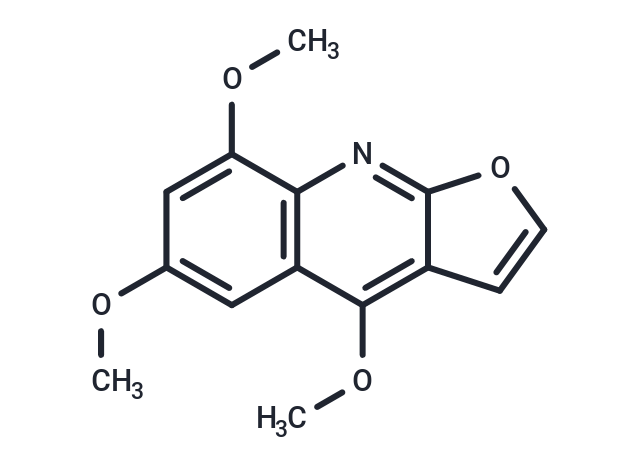Shopping Cart
- Remove All
 Your shopping cart is currently empty
Your shopping cart is currently empty

Maculosidine affect the PS I electron acceptors on leaf discs, it can inhibit ATP synthesis, basal, phosphorylating and uncoupled electron transport acting as Hill reaction inhibitors on spinach chloroplasts.

| Pack Size | Price | Availability | Quantity |
|---|---|---|---|
| 5 mg | $900 | Backorder | |
| 1 mL x 10 mM (in DMSO) | $920 | Backorder |
| Description | Maculosidine affect the PS I electron acceptors on leaf discs, it can inhibit ATP synthesis, basal, phosphorylating and uncoupled electron transport acting as Hill reaction inhibitors on spinach chloroplasts. |
| In vitro | METHODS AND RESULTS:In the search for natural inhibitors of plant growth, we investigate the mechanism of action of the natural furoquinoline alkaloids isolated from Balfourodendron riedelianum (Rutaceae): evolitrine (1), kokusaginine (2), γ-fagarine (3), skimmianine (4) and Maculosidine (5) on the photosynthesis light reactions. Their effect on the electron transport chain on thylakoids was analyzed. Alkaloids 1, 2, 4 and 5 inhibited ATP synthesis, basal, phosphorylating and uncoupled electron transport acting as Hill reaction inhibitors on spinach chloroplasts. Alkaloid 3 was not active. The inhibition and interaction site of alkaloids 1, 2, 4 and 5 on the non-cyclic electron transport chain was studied by polarography and fluorescence of the chlorophyll a (Chl a). CONCLUSIONS: The results indicate that the target for 1 was localized on the donor and acceptor side of PS II. In addition alkaloids 2 and 5 affect the PS I electron acceptors on leaf discs. |
| Molecular Weight | 259.26 |
| Formula | C14H13NO4 |
| Cas No. | 522-19-0 |
| Relative Density. | 1.26g/cm3 |
| Storage | Powder: -20°C for 3 years | In solvent: -80°C for 1 year | Shipping with blue ice. |

Copyright © 2015-2025 TargetMol Chemicals Inc. All Rights Reserved.